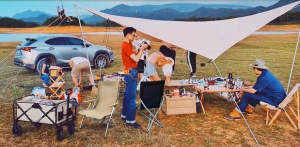News Center+ 查看更多
News Center
+ 查看更多
Adventure-Ready Gear: Examining Advanced Features in Camping Equipment+ 查看更多
Adventure-Ready Gear: Examining Advanced Features in Camping Equipment
+ 查看更多
Date:2023-12-14
Camping equipment has undergone remarkable advancements, integrating cutting-edge features that enhance functionality, durability, and convenience for outdoor enthusiasts.
1. High-Tech Fabrics Revolutionizing Gear
Innovative fabrics like Dyneema, Cordura, and Gore-Tex are transforming camping equipment. Dyneema, known for its strength-to-weight ratio, is employed in tents and backpacks, offering exceptional durability while keeping weight to a minimum. Cordura, prized for its abrasion resistance, is utilized in packs and gear requiring toughness. Gore-Tex, a breathable and waterproof material, is prominent in outerwear, ensuring comfort in varying weather conditions.
2. Lightweight and Strong Frame Designs
Frame designs in tents, backpacks, and camping furniture have evolved. Utilizing aerospace-grade aluminium alloys or carbon fibre, manufacturers create lighter yet sturdier frames. These advanced materials offer durability while minimizing the overall weight of the gear, perfect for backpackers and adventurers seeking lightweight yet robust equipment.
3. Integrated Solar Technology
Camping equipment now integrates solar technology for power generation. Backpacks with built-in solar panels allow campers to charge electronic devices on the go. Tents with solar fabric can harness sunlight to power LED lighting or charge batteries, offering sustainable energy solutions in remote locations.
4. Smart Connectivity and GPS Integration
Innovations have led to camping gear with integrated connectivity. GPS-enabled devices, from smartwatches to tents, aid in navigation and tracking. Some camping equipment integrates Bluetooth connectivity for remote control of tent features or to sync with smartphone apps, enhancing convenience and safety.
5. Modular and Versatile Designs
Modular designs have gained traction in camping equipment. Tents with adaptable configurations allow customization based on weather conditions or group size. Backpacks with modular compartments offer versatility in organizing gear, catering to individual preferences.
6. Insulation Technologies in Sleeping Gear
Advanced insulation technologies in sleeping bags and pads optimize warmth and weight. Innovative materials like PrimaLoft, ThermoBall, or aerogel are used for superior insulation. Sleeping pads incorporate heat-reflective materials, enhancing thermal efficiency for a cosy night’s sleep in various conditions.
7. Water Purification Systems
Camping gear now integrates advanced water purification systems. Portable filters or UV purification devices are built into bottles or hydration packs, ensuring access to clean and safe drinking water, even from natural sources.
8. User-Centric Designs and Ergonomics
Modern camping gear emphasizes user-centric designs and ergonomics. Adjustable straps, padded harnesses, and ergonomic shapes enhance comfort during prolonged use. Intuitive and easy-to-use features cater to campers seeking hassle-free experiences in the wilderness.
Conclusion
The evolution of camping equipment showcases a convergence of technology and outdoor adventurism. Advanced fabrics, smart integration, modularity, and comfort-driven designs redefine outdoor experiences. With these innovations, campers can embark on adventures with gear tailored for durability, convenience, and optimal performance in diverse outdoor settings.

